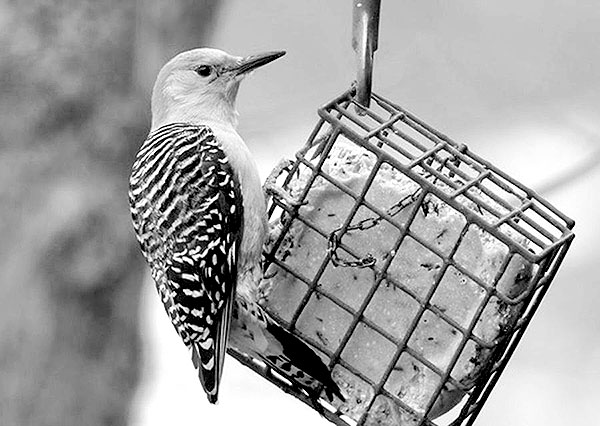Winter is hard on all the native birds that stay in our area. By the time January arrives most seeds have already been eaten off the ground and berries have fallen from the trees and shrubs. Luckily for our feathered friends, winter back yard bird watching is now one of America’s favorite hobbies. We spend millions of dollars every year feeding wild birds in order to attract our winged friends within easy view.
Birds with diets that depend mostly on insects have the hardest time finding enough proteins and calories in other food sources such as fruit and seeds. For these birds ‘suet’ is extremely valuable.
Suet is a winter bird food made from animal fat that is easily digested and metabolized by many birds; it’s a high-energy food, especially valuable in cold weather. Suet is particularly attractive to woodpeckers, nuthatches, chickadees, blue jays, tree creepers, and starlings when they visit feeders. Of course, squirrels love suet and will gobble every bite if permitted.
Suet cakes are sold almost everywhere we shop. Garden shops, hardware stores, Christmas Tree shops, tractor supply and even our local grocery stores. I try to find suet cakes at the best price and stock up on them. They can be stored in a cool spot or put in a freezer for long term storage.
Commercial suet feeders are available, and are an inexpensive investment. They have a latch to close them but I also use a twist tie to prevent squirrels from opening the cage and knocking the cake on the ground.
Place the suet in feeders or net onion bags at least five feet from the ground to keep it out of the reach of dogs.
Do not put out suet during hot weather as it can turn rancid. During hot weather the dripping fat can damage natural waterproofing on bird feathers causing permanent damage and a shorter life; not what we are hoping for when we feed birds.
Today suet cakes come in a wide variety of ingredients and flavors. Everything from citrus., blueberry or hot chili. The birds are coming for the fat, so the simpler the indigents, the better. If I find a suet with corn, I put it back. Corn is the least nutritional “filler” with only two percent protein.
It is possible to make your own suet from leftover fat. You can find information on how to make it on the internet and on Youtube.
Squirrels, starlings and other large birds will scare away the birds we want to attract. I use a simple trick that helps avoid or limit this problem. Hang your suet cake feeder upside down. When I unwrap the suet, I only take off the top wrapper, leaving the plastic tray on the rest of the cake. Place the suet in the feeder with the exposed suet facing down. This makes it difficult for the larger birds to hang on for long and they soon search for an easier food supply. The smaller birds are able to cling upside down and have no trouble eating the suet.
Happy back yard bird watching,
James

(above) Feeding suet will attract amazing birds like this ‘Red bellied woodpecker’
to your garden all winter long.





